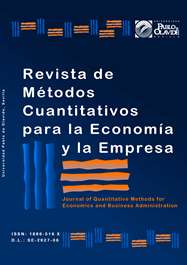Hybrid heuristic model for inventory routing management in a fuel comercial entity
DOI:
https://doi.org/10.46661/revmetodoscuanteconempresa.3574Keywords:
vehicle routing problem, inventory management, heuristics methods, binary linear programmingAbstract
The inventory routing problem is a complex topic recognized by the scientific literature. This work shows up this kind of problem, particularly a problem with freight traffic indicator as an objective for optimization, also a mathematical model and procedure for the resolution of this problem in an entity that sales fuel in eastern region of Cuba. For it, we were used heuristics combined methods of decomposition and reduction, integrated with binary linear programming, for the determination of the routing for vehicles toward the clients. The objective was to simplify the problem and to offer a satisfying performance based on the achievement of inventory levels according to a planned covering level, the rational use of the vehicles. Finally, it was proven in a case of study based on a real operative situation of the company studied.
Downloads
References
Andersson, H., Hoff, A., Christiansen, M., Hasle, G., & Løkketangen, A. (2010). Industrial aspects and literature survey: Combined inventory management and routing. Computers & Operations Research, 37(9), 1515-1536.
Archetti, C., Coelho, L.C., & Speranza, M.G. (2019). An exact algorithm for the inventory routing problem with logistic ratio. Transportation Research Part E: Logistics and Transportation Review, 131, 96-107.
Archetti, C., Desaulniers, G., & Speranza, M.G. (2017). Minimizing the logistic ratio in the inventory routing problem. EURO Journal on Transportation and Logistics, 6(4), 289-306.
Braekers, K., Ramaekers, K., & Van Nieuwenhuyse, I. (2016). The vehicle routing problem: State of the art classification and review. Computers & Industrial Engineering, 99, 300-313.
Campbell, A., Clarke, L., Kleywegt, A., & Savelsbergh, M. (1998). The inventory routing problem. In Fleet management and logistics (pp. 95-113). Boston, MA: Springer.
Campbell, A.M., & Savelsbergh, M.W. (2004). A decomposition approach for the inventory-routing problem. Transportation science, 38(4), 488-502.
Cattaruzza, D., Absi, N., Feillet, D., & González-Feliu, J. (2017). Vehicle routing problems for city logistics. EURO Journal on Transportation and Logistics, 6(1), 51-79.
Coelho, L.C., Cordeau, J.F., & Laporte, G. (2014). Thirty years of inventory routing. Transportation Science, 48(1), 1-19.
Delgado, J.A.C., Avalos, L.C.M., Delgado, E.R., & Puycán, L.A.L. (2015). Optimización de programas matemáticos con programación dinámica. Ciencia & Desarrollo, 19, 77-83.
Eksioglu, B., Vural, A.V., & Reisman, A. (2009). The vehicle routing problem: A taxonomic review. Computers & Industrial Engineering, 57(4), 1472-1483.
Hart, W.E. (2009). Python optimization modeling objects (Pyomo). In Operations Research and Cyber-Infrastructure (pp. 3-19). Boston, MA: Springer.
Lao, Y.O., Vega, L.O., Marrero, F., & Pérez, M.C. (2017). Procedimiento para modelar recursos restrictivos en el sistema logístico de empresas comercializadoras. Ingeniería Industrial, 38(1), 43-55.
Li, K., Chen, B., Sivakumar, A.I., & Wu, Y. (2014). An inventory-routing problem with the objective of travel time minimization. European Journal of Operational Research, 236(3), 936-945.
Oliphant, T.E. (2007). Python for scientific computing. Computing in Science & Engineering, 9(3), 10-20.
ONEI (2019). Anuario Estadístico de Cuba 2018. La Habana, Cuba, Edición 2019.
Palhares, R.A., & Araújo, M.C.B. (2018, December). Vehicle Routing: Application of Travelling Salesman Problem in a Dairy. In 2018 IEEE International Conference on Industrial Engineering and Engineering Management (IEEM) (pp. 1421-1425). IEEE.
Pecin, D., Contardo, C., Desaulniers, G., & Uchoa, E. (2017). New enhancements for the exact solution of the vehicle routing problem with time windows. INFORMS Journal on Computing, 29(3), 489-502.
Piqueras, V.Y., & Folgado, J.R.M. (2002). Optimización heurística económica aplicada a las redes de transporte del tipo VRPTW. Valencia: Universidad Politécnica de Valencia.
Rahim, M.K.I.A., Iteng, R., & Ahmad, M.A. (2017). A Deterministic Inventory Routing Model for the Single-period Problems with Finite Time Horizon. International Journal of Supply Chain Management, 6(2), 196-201.
Ritzinger, U., Puchinger, J., & Hartl, R.F. (2016). A survey on dynamic and stochastic vehicle routing problems. International Journal of Production Research, 54(1), 215-231.
Soysal, M., Bloemhof-Ruwaard, J.M., Haijema, R., & Van der Vorst, J.G. (2018). Modeling a green inventory routing problem for perishable products with horizontal collaboration. Computers & Operations Research, 89, 168-182.
Uchoa, E., Pecin, D., Pessoa, A., Poggi, M., Vidal, T., & Subramanian, A. (2017). New benchmark instances for the capacitated vehicle routing problem. European Journal of Operational Research, 257(3), 845-858.
Downloads
Published
How to Cite
Issue
Section
License
Copyright (c) 2021 Journal of Quantitative Methods for Economics and Business Administration

This work is licensed under a Creative Commons Attribution-ShareAlike 4.0 International License.
Submission of manuscripts implies that the work described has not been published before (except in the form of an abstract or as part of thesis), that it is not under consideration for publication elsewhere and that, in case of acceptance, the authors agree to automatic transfer of the copyright to the Journal for its publication and dissemination. Authors retain the authors' right to use and share the article according to a personal or instutional use or scholarly sharing purposes; in addition, they retain patent, trademark and other intellectual property rights (including research data).
All the articles are published in the Journal under the Creative Commons license CC-BY-SA (Attribution-ShareAlike). It is allowed a commercial use of the work (always including the author attribution) and other derivative works, which must be released under the same license as the original work.
Up to Volume 21, this Journal has been licensing the articles under the Creative Commons license CC-BY-SA 3.0 ES. Starting from Volume 22, the Creative Commons license CC-BY-SA 4.0 is used.










